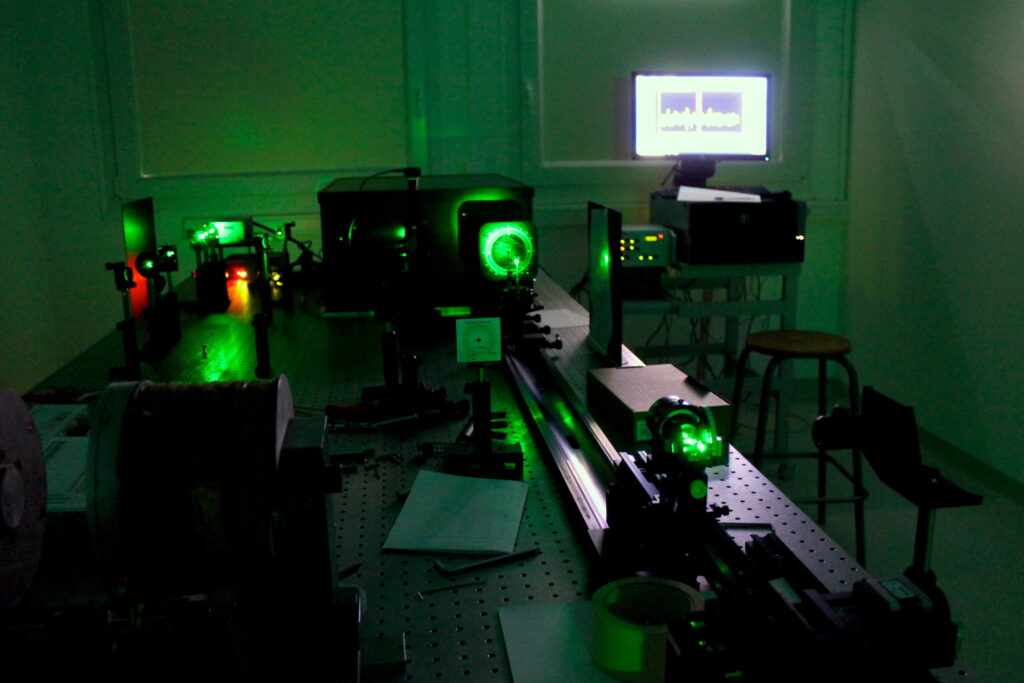
BLS for magnetic systems
The inelastic light scattering by propagating excitations (first proposed by Léon Brillouin in 1914, and called Brillouin light scattering – BLS) provides an access to the dispersion relation of the excitations, and its modification by external stimuli. As visible light is employed, the wavevectors that can be studied are relatively small (maximum value 4p/L, i.e. 23.6 rad./mm for the green laser with L= 0.532 mm). The most studied excitation is the (acoustic) phonon. For magnetism, the relevant excitations are the spin waves. The wavevectors probed allow to leave the purely dipolar limit and enter the region of dipole-exchange spin waves.
Magnetic BLS can be seen as a magnetic resonance (MR) experiment (ferromagnetic resonance, but also ferrimagnetic resonance and even antiferromagnetic resonance), with in addition the possibility to probe non-zero wavevectors. As such, it allows extracting the same parameters as obtained by zero wavevector magnetic resonance, which are the magnetic anisotropy, the gyromagnetic factor, the damping parameter, as well as the inhomogeneous broadening of the resonance lines. Compared to MR, it has the advantage of being optically probed, which is a big asset for intermetallic ferromagnetic samples and also allows local probing of MR, down to a few tens of micrometers. Also, as thermally excited spin waves are measured, there is no external pumping of these excitations, avoiding non-linearities and parasitic decay channels such as three-magnon scattering. The disadvantages of BLS are the much poorer frequency resolution (due to the Fabry-Pérot setup employed, instead of the extreme spectral purity of microwave sources), and the long counting times, typically of the order of the hour per spectrum (with extremely wide variations depending on the sample structure and properties).
The wavevector capability brings the possibility to measure other micromagnetic parameters. Prominent among these is the anti-symmetric exchange known as Dzyaloshinskii-Moriya interaction (DMI), which manifests in the appropriate geometry as a frequency difference, between two spin waves with the same wavevector but opposite propagating directions, proportional to the wavevector. The DMI has appeared in the last years as a key feature of ultrathin magnetic films, due to an interfacial DMI energy. In addition to DMI, the conventional exchange enters the effective fields expressions via a wavevector squared term, allowing in principle the measurement of exchange.
BLS spectrometry at the LPS
The LPS BLS setup is operational since 2019. It is based on a TFP2-HC spectrometer (JRS Instruments, The Table Stable Ltd., Switzerland). Magnetic field is supplied by permanent magnets (up to 0.6 T) or by a water-cooled electromagnet (up to 2.2 T). The sample environment is adapted to the experimental needs.
Some references
- Spin-orbit coupling in single-layer ferrimagnets: direct observation of spin-orbit torques and chiral textures, S. Krishnia, E. Haltz, L. Berges, L. Aballe, M. Foerster, L. Bocher, R. Weil, A. Thiaville, J. Sampaio, A. Mougin, Phys. Rev. Applied 16, 024040(8) (2021).
- Spatial extent of the Dzyaloshinskii-Moriya interaction at metallic interfaces, W. Legrand, Y. Sassi, F. Ajejas, S. Collin, L. Bocher, H. Jia, M. Hoffmann, B. Zimmermann, S. Blügel, N. Reyren, V. Cros, A. Thiaville,Phys. Rev. Mater. 6, 024408(12) (2022).
- Quantitative analysis of spin wave dynamics in ferrimagnets across compensation points, E. Haltz, J. Sampaio, S. Krishnia, L. Berges, R. Weil, A. Mougin, A. Thiaville, Phys. Rev. B 105, 104414(8) (2022).
- Interfacial potential gradient modulates Dzyaloshinskii-Moriya interaction in Pt/Co/metal multilayers, F. Ajejas, Y. Sassi, W. Legrand, S. Collin, J. Pena Garcia, A. Thiaville, S. Pizzini, N. Reyren, V. Cros, A. Fert,Phys. Rev. Mater. 6, L071401(5) (2022).
